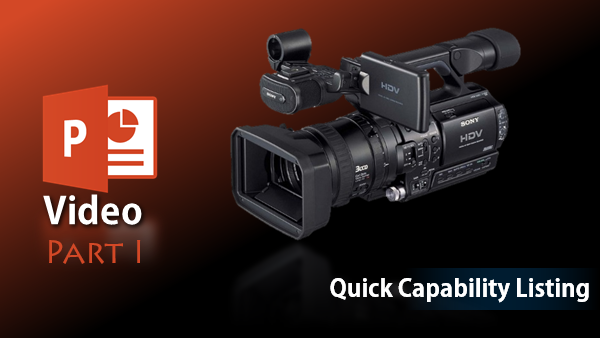
Yes – I am starting with a recap. There is so much you can do with Videos in PowerPoint (2010 onwards), that it will require many articles. In this article, I will explain ALL that you can do with videos. Later we will cover specific features in-depth.
In one word you can do “EVERYTHING” with a video that you can do with a picture or a shape. That is immensely sophisticated yet very easy to do …
Photo credit: AV Hire London / Foter / CC BY
Contents
What type of videos can be added
All common types are supported. FLV is NOT supported – in fact it is not a video format at all. We will cover the types in detail later. However, remember that some features are NOT available in some type of videos. Maximum feature set is available for WMV videos (or AVI).
There is no linking. Video goes with the presentation.
No more surprises on stage. Inserting a video ACTUALLY INSERTS IT into the PowerPoint template.
File size
Inserting the video will increase the presentation size as per the original video size. But don’t worry. PowerPoint is very smart. It can compress videos – without much compromise on the visual quality to save lot of space. If you are using only a trimmed part of video, the rest of video can be removed – reducing file size further.
Setting it up
Many things can be done to just make the video run the way you want it to:
- Decide whether it should run on click or automatically
- Mute the audio associated with it or not
- Should it replay (loop) after one run is finished
- Should it run full screen or exactly the way it appears on the slide
- Change the Poster Frame (the default image seen when video is not running)

How much of the video to play?
- Do you want to show full length or choose the area to play (Trim)
- Only ONE contiguous area can be trimmed. Multiple trims require multiple copies of the video.
Change the look
This is where PowerPoint shines. You can treat the video as though it was a picture or a shape. You can
- Resize, Crop, Align, Rotate
- Put borders, shadow, 3D rotation and 3D effects, glow, soft edges and even reflection
- Use all the Video Styles – a pre-created combination of these effects
- Recolor the vide – extremely powerful and creative option
- Change brightness and contrast, recolor the entire video (Black and White, Sepia, etc.)

Remember that all these settings have to work WHILE the video is running. Technically doing all this is quite complex but as a user, you don’t have to worry. Just do it and it runs!
The things you cannot do are change Sharpness and apply Artistic effects like sketch, blur, glass, detect edges, water color, paint brush, film grain and so on. Those require extremely complex processing and require dedicated software like Adobe Premier and / or Adobe After Effects (and many other professional apps).
Change the behaviour
Yes – you guessed it right – ALL types of animation are applicable – Entry, Emphasis, Exit and Motion Path. Within these, some animation types are not supported.
One very useful animation which is extremely powerful is Transparency Emphasis effect. This allows you to superimpose two videos and have the front video partially transparent. Amazing impact can be generated using this technique.
During the playback
While running the presentation, the video can be paused, rewound, scrubbed, volume altered. Lot of keyboard shortcuts are also available for quick navigation and video control.
Zoom, Grow / Shrink also work beautifully. Reflection is live which is extremely impressive to the audience.
Even the software laser pointer – press Ctrl and drag mouse – also works on top of a running video.
Make other things happen based upon video play
Finally, you can define bookmarks – or areas of interest – like beginnings of important scenes. These bookmarks can be used to run ANY ANIMATION on ANY OBJECT.
This is probably the most powerful feature – something most people are completely unaware of. This allows for sophisticated titling – multiple video synchronized playback, video play with zoom in – picture-in-picture scenarios, the list is endless.
Compatibility
WMV and AVI videos will run on any PC (laptop / tablet) running Windows 7 or above. Other types of video require special software to run (technically called a Codec). If you carry the presentation to another laptop (like in conferences or customer meetings), the video may not run. PowerPoint is extremely smart and detects this issue while you are editing the presentation on your PC. It then warns you about the compatibility problem and provides a very handy option Optimize Compatibility.
Just choose the option and leave the rest to PowerPoint.
What next
This was just a list of what is possible. In future articles, we will see details of some of these capabilities. But I suggest you try it out yourself and enjoy the process of learning.


